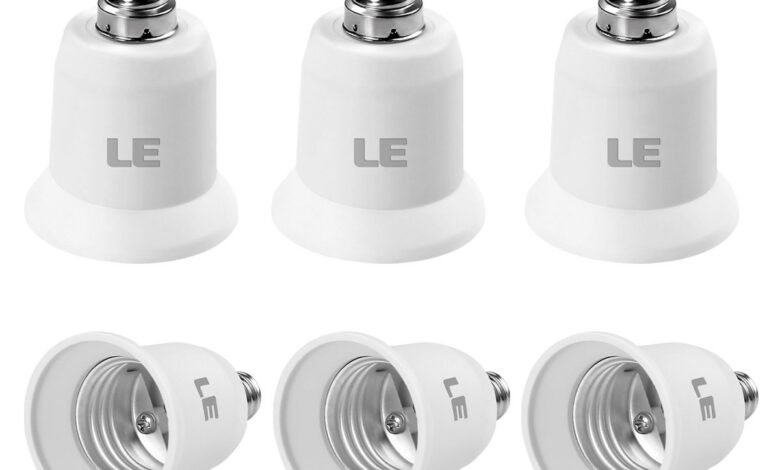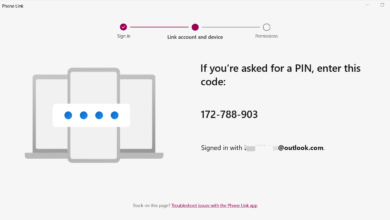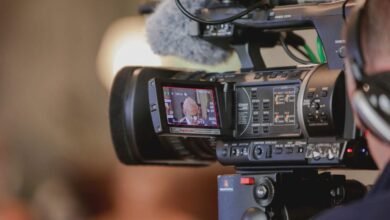Light Bulb Base Adapters: Your Simple Solution to Fixture Mismatches

Introduction
Have you ever bought the perfect light bulb only to discover it doesn’t fit your fixture? Or perhaps you found an amazing vintage lamp at a thrift store, but modern bulbs won’t screw in properly. This frustrating scenario happens more often than you might think, but there’s a simple solution that can save you time, money, and the hassle of returning products: light bulb base adapters.
There are small, inexpensive devices that bridge the gap between incompatible bulb and fixture combinations. They allow you to use virtually any bulb in any socket, opening up endless possibilities for your lighting choices. Whether you’re dealing with different base sizes, want to convert from one bulb type to another, or need to make an old fixture work with modern LED technology, these handy adapters can solve your problem in seconds.
This guide will walk you through everything you need to know about light bulb base adapters, from understanding the different types available to choosing the right one for your specific needs. We’ll also cover proper installation techniques, safety considerations, and troubleshooting tips to help you make the most of these versatile lighting accessories.
Types of Light Bulb Base Adapters
Understanding the various types of light bulb base adapters available will help you select the perfect solution for your lighting needs. Each adapter serves a specific purpose, converting between different base sizes or bulb technologies.
Size Conversion Adapters
The most common type of light bulb base adapter converts between different screw base sizes. These adapters address the size mismatch between your fixture and your desired bulb.
E26 to E12 adapters reduce the connection from a standard medium base (E26) fixture to accommodate a smaller candelabra base (E12) bulb. This type is particularly useful when you want to use decorative candelabra bulbs in standard fixtures.
E12 to E26 adapters work in the opposite direction, allowing you to install standard-sized bulbs in fixtures designed for smaller candelabra bases. This conversion is helpful when you need more light output than typical candelabra bulbs provide.
E26 to E17 adapters convert standard fixtures to accommodate intermediate base bulbs, which are commonly used in appliances and some specialty fixtures.
Specialty Base Adapters
Beyond the standard screw bases, several specialty adapters handle unique bulb types and connections.
Bayonet to screw adapters convert between bayonet-style connections (common in some imported fixtures) and standard screw bases. These adapters feature a twist-and-lock bayonet connection on one end and screw threads on the other.
GU10 to E26 adapters allow you to use standard bulbs in fixtures designed for GU10 spotlight bulbs. This conversion is useful when retrofitting track lighting or recessed fixtures.
Fluorescent to LED adapters help you convert old fluorescent fixtures to work with modern LED technology without rewiring the entire fixture.
Multi-Socket Adapters
Some adapters don’t just convert base sizes they multiply your lighting options.
Socket splitters convert one socket into two, three, or even more sockets, allowing you to install multiple bulbs in a single fixture. These are available in various configurations, including parallel and perpendicular arrangements.
Extension adapters add length between your fixture and bulb, which can be helpful when you need to position a bulb differently or create clearance for larger bulbs.
How to Choose the Right Light Bulb Base Adapter
Selecting the correct this requires careful consideration of several factors to ensure compatibility, safety, and optimal performance.
Measure Your Current Setup
Start by identifying both your fixture’s socket type and your desired bulb’s base type. Socket and base types are usually marked on the fixture or bulb, but you can also measure them directly.
For screw bases, measure the diameter of the threaded portion. E26 bases measure 26mm in diameter, E17 bases measure 17mm, and E12 bases measure 12mm. If you don’t have a metric ruler, E26 bases are approximately 1 inch in diameter, while E12 bases are roughly half an inch.
Check the depth of your fixture as well. Some adapters add length to the overall bulb assembly, which could cause clearance issues in shallow fixtures or enclosed housings.
Consider Wattage Limitations
Every adapter has a maximum wattage rating that you must not exceed. This rating represents the highest wattage bulb you can safely use with that particular adapter.
Check both the adapter’s wattage rating and your fixture’s rating, then use whichever is lower. For example, if your fixture is rated for 60 watts but your adapter is only rated for 40 watts, you should not exceed 40 watts.
LED bulbs make this consideration easier since they typically draw much less wattage than their incandescent equivalents while producing similar light output. A 10-watt LED bulb might produce the same amount of light as a 60-watt incandescent bulb.
Evaluate Heat Dissipation Needs
Heat buildup can be a significant concern when using adapters, especially in enclosed fixtures or with high-wattage bulbs.
Look for adapters made from heat-resistant materials like ceramic or high-quality thermoplastic. Metal adapters also dissipate heat well but may cost more than plastic alternatives.
Avoid using adapters with high-heat bulbs like halogen or high-wattage incandescent bulbs in enclosed fixtures. LED bulbs generate much less heat and are generally safer to use with adapters.
Step-by-Step Installation Guide
Installing a light bulb base adapter is typically straightforward, but following proper procedures ensures safety and optimal performance.
Preparation Steps
Before beginning any installation, turn off the power to the fixture at the wall switch. For ceiling fixtures or hard-wired installations, consider turning off power at the circuit breaker for added safety.
Allow any existing bulbs to cool completely if they were recently in use. Hot bulbs can cause burns and may be difficult to remove safely.
Gather your materials: the adapter, your new bulb, and possibly a stepladder or stool if you’re working with ceiling fixtures.
Installing the Adapter
Remove any existing bulb from the fixture by turning it counterclockwise until it comes free. Set it aside in a safe location where it won’t roll or fall.
Take your adapter and identify which end connects to the fixture and which end receives the bulb. Most adapters are clearly marked, but the fixture end typically has female threads (internal threads) while the bulb end has male threads (external threads).
Screw the adapter into the fixture by turning it clockwise until it’s snug. Don’t overtighten, as this can damage the adapter threads or the fixture socket.
Installing Your Bulb
Once the adapter is securely in place, install your chosen bulb by screwing it into the adapter’s bulb socket. Turn clockwise until snug, but again, avoid overtightening.
Test the installation by turning the power back on and activating the light switch. The bulb should illuminate normally without flickering or unusual noises.
If the bulb doesn’t work, turn off the power and check all connections. Make sure both the adapter and bulb are fully seated and that you haven’t exceeded any wattage limitations.
Safety Tips and Precautions
Using light bulb base adapters safely requires attention to several important considerations that protect both you and your property.
Electrical Safety Guidelines
Never install or remove adapters or bulbs with the power on. Even if you’re careful, accidental contact with live electrical components can cause serious injury.
Inspect adapters before use for any cracks, damage, or loose components. Damaged adapters can create fire hazards or electrical shorts that may damage your fixture or electrical system.
Ensure all connections are secure but not overtightened. Loose connections can cause arcing and heat buildup, while overtightened connections can damage threads and make future removal difficult.
Heat Management
Monitor your installation for excessive heat buildup, especially during the first few hours of use. Touch the adapter periodically (when the power is off and components have cooled) to check for unusual warmth.
Avoid using adapters in fully enclosed fixtures with high-wattage bulbs. The confined space can trap heat and create fire hazards.
Consider upgrading to LED bulbs when using adapters, as they generate significantly less heat than incandescent or halogen alternatives.
Load Limitations
Respect both the adapter’s wattage rating and your fixture’s rating. Using bulbs that exceed these limits can cause overheating, fire hazards, and premature failure of both the adapter and fixture.
When using socket splitters or multi-bulb adapters, calculate the total wattage of all bulbs combined. This total must not exceed the fixture’s maximum rating.
Check your electrical system’s capacity if you’re adding multiple adapters or increasing the total lighting load in a room. Overloaded circuits can trip breakers or create fire hazards.
Common Issues and Troubleshooting
Even with proper installation, you may encounter issues when using light bulb base adapters. Understanding common problems and their solutions helps you address issues quickly and safely.
Connection Problems
Loose connections are among the most frequent issues with adapter installations. Symptoms include flickering lights, intermittent operation, or complete failure to illuminate.
Check that both the adapter-to-fixture connection and the bulb-to-adapter connection are secure. Turn off power before adjusting any connections.
If connections appear secure but problems persist, inspect the adapter threads and fixture socket for damage or debris. Clean threads gently with a dry cloth and check for bent or damaged components.
Compatibility Issues
Sometimes adapters and bulbs that should work together don’t perform as expected. This issue often stems from minor dimensional differences between manufacturers.
If a bulb seems loose in an adapter, double-check that you have the correct adapter type. Some manufacturers have slightly different thread pitches or depths that can affect fit.
When bulbs feel tight but won’t screw in completely, don’t force them. This usually indicates a mismatch that could damage either component.
Heat-Related Problems
Excessive heat can cause adapters to discolor, become brittle, or fail completely. Signs of heat problems include brown or black discoloration, melted plastic, or a burning smell.
If you notice heat-related damage, replace the adapter immediately and consider switching to a lower-wattage bulb or LED alternative.
Improve ventilation around fixtures when possible, and avoid using adapters in fully enclosed housings with high-wattage bulbs.
Benefits of Using Light Bulb Base Adapters
Light bulb base adapters offer numerous advantages that make them valuable tools for both homeowners and professionals.
Cost Savings and Flexibility
Rather than replacing entire fixtures when you want different bulb types, adapters let you modify existing installations for a fraction of the cost. A quality adapter typically costs less than $10, while fixture replacement can cost hundreds of dollars.
Adapters also allow you to take advantage of sales and bulk purchases on bulbs that might not normally fit your fixtures. You can buy LED bulbs in whatever base size offers the best value, then use adapters to make them compatible.
Expanded Design Options
With adapters, you’re not limited to bulb types that directly fit your fixtures. You can use decorative candelabra bulbs in standard fixtures, install vintage Edison bulbs in modern sockets, or use specialty bulbs designed for specific effects.
This flexibility is particularly valuable when decorating for special events or seasons. You can easily switch between different bulb styles without rewiring or replacing fixtures.
Environmental Benefits
Adapters help extend the useful life of older fixtures that might otherwise be discarded due to bulb compatibility issues. This reduces waste and supports sustainability efforts.
They also make it easier to upgrade to energy-efficient LED bulbs in older fixtures, reducing energy consumption and environmental impact without requiring electrical work.
Making the Most of Your Lighting Setup
Light bulb base adapters are simple, affordable solutions that can transform your lighting options and solve compatibility problems between bulbs and fixtures. By understanding the different types available, choosing the right adapter for your needs, and following proper installation and safety procedures, you can expand your lighting possibilities while maintaining safety and performance.
Remember to always prioritize safety by turning off power during installation, respecting wattage limitations, and monitoring for heat buildup. With proper use, light bulb base adapters can help you create the perfect lighting environment while making the most of your existing fixtures and bulb investments.
Whether you’re dealing with vintage fixtures, specialty bulb requirements, or simply want more flexibility in your lighting choices, these versatile adapters offer an elegant solution that’s both practical and affordable.
Frequently Asked Questions
Can I use multiple adapters together to achieve different conversions?
While it’s technically possible to chain adapters together, this practice is not recommended. Multiple adapters increase the risk of loose connections, add length that may not fit in your fixture, and can create heat buildup issues. It’s safer and more reliable to find a single adapter that makes the conversion you need.
Are light bulb base adapters safe to use outdoors?
Most standard adapters are designed for indoor use only. If you need adapters for outdoor fixtures, look specifically for products rated for outdoor use, which will have weather-resistant materials and construction. Always check the adapter’s specifications and ratings before using it in outdoor applications.
How do I know if my fixture can handle the extra weight of an adapter and bulb?
Most adapters are lightweight and add minimal weight to your bulb assembly. However, if you’re using heavy specialty bulbs or multiple adapters, check your fixture’s specifications. Pendant lights and track lighting systems have weight limits that should not be exceeded.
Can adapters affect the light output or color of my bulbs?
Quality adapters should not affect light output or color, as they only provide an electrical connection between the fixture and bulb. If you notice changes in light quality, check for loose connections or heat buildup, which can affect bulb performance.
Do light bulb base adapters work with dimmer switches?
Adapter compatibility with dimmers depends on the bulb you’re using, not the adapter itself. The adapter simply provides a connection, so dimmer compatibility is determined by whether your bulb type (LED, incandescent, etc.) is compatible with your dimmer switch.



